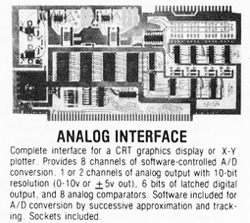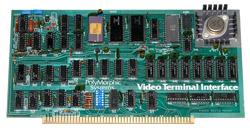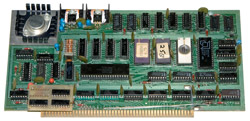|
PolyMorphic's Board-Level Products
|
Analog Interface - The company started by producing a few computer boards which could be used in other S-100 based machines.
The first of these was an A-to-D, D-to-A board (analog-to-digital, digital-to-analog converter). It would have
been most useful to scientists and hobbyists.
Analog Interface Manual
|
 |
|
Video Terminal Interface (VTI) - In that era, many systems used the mainframe approach to user interface: a separate video terminal to provide the screen and keyboard. Poly's second offering was a VTI (video terminal interface) card which could substitute for an external terminal. You'd also have to purchase a keyboard and a video monitor, or you could modify some TV sets to add a video input.
The VTI produced a 16-line display of 64 characters per line. This totaled 1024 characters, a binary number which simplified the design. 64 characters was also about the maximum which could be displayed clearly due to the bandwidth limitations of standard televisions. Character patterns were stored in a font ROM, with 7x9 dot resolution.
Each character position could also be divided into a 2x3 grid, giving the screen a block graphics resolution of 128 (H) by 48 (V). This was suitable for simple line-drawing, games and bar charts. Radio Shack's original TRS-80 used the same 64x16 screen layout and 2x3 graphics blocks.
The video memory was mapped into a portion of the CPU's address space. This meant that updates to the screen were extremely fast, since writing a single byte to memory would make a character appear on screen.
The VTI also provided a TTL-level interface to a keyboard. Poly offered several different keyboard models, including the Keyboard III with four function keys and a numeric keypad.
VTI Manual
Keyboard Manual
|


|
|
Central Processing Unit (CPU) - To build a working computer, you need a processor board. Poly's CPU was released as part of the Poly-88 system, and, except for the ROMs, remained the same design throughout all of PolyMorphic's systems. It used an Intel 8080 chip, clocked at 1.8432 MHz instead of the rated 2 MHz. This allowed the same clock signal to be subdivided into standard bit rates for the onboard 8251 USART (serial port interface chip).
Onboard memory consisted of three sockets, each capable of holding a 1024-byte ROM. In Poly-88 systems, only the first socket was occupied. The other two were available for additional software, such as the disk boot loader used in the System 8813. The CPU also contained 512 bytes of RAM.
The CPU had two sockets connecting the USART signals to optional "mini-cards," interface adapters for an RS232 or cassette tape interface. The RS232 interface was intended for connection to a serial printer (predating the parallel printer interface commonly used with IBM-PC computers). It could also be used with a modem. The cassette tape interface (pictured right) supported program storage and loading from consumer-grade cassette tape recorders, using either Kansas City standard or higher speed Manchester encoded signals (called Polyphase by the Poly manuals).
Poly-88 Assembly & Test Manual
Cassette Interface Manual
Printer Interface Manual
|


|
|
Random Access Memory (RAM) - The 512 bytes of RAM on the CPU card was barely enough to boot the system, and certainly not enough to run serious programs. You could add other vendors' RAM cards to the '88, or you could purchase a Poly RAM card.
Poly offered an 8K static RAM card (top, in the figure to right) and a 16K dynamic RAM card (bottom). Dynamic RAM had the advantange of using less power and taking less space, but it wasn't considered to be as reliable.
With five slots available in the Poly-88, you could configure a system with CPU, VTI, and three RAM cards for a total of 48K. Now we're getting serious.
16K Dynamic RAM Manual
|
 |
|
Prototyping Board (IdeaBoard) - This one was for the true hobbyist/hacker with a soldering iron in his hand.
It had the necessary components of any S-100 card, such as memory and I/O decoding logic, data bus buffering, and power supply regulation. But mainly, it had a large, empty area where the budding engineer could create his own circuits.
|

|
Disk Controller - Poly released their first disk controller as part of the System 8813. It worked with Shugart SA-400 single-sided, single-density (SSSD) mini-floppy drives, using hard-sectored diskettes which stored a total of 90K bytes each. Up to three drives could be installed in the system.
A later, more powerful disk controller card worked with double-sided, double-density drives, including both 5" and 8" drives. This controller had an onboard Z80 processor, giving it more computing power than the system's main 8080 CPU chip.
The largest Poly configurations could contain three mini-floppy drives and four full-size drives, with drive numbers from <1< to <7<.
Late in their lifetime, PolyMorphic also offered a hard drive subsystem called the HD/18. More about that on the 8813 page. |
 |
|
|
|
|
|